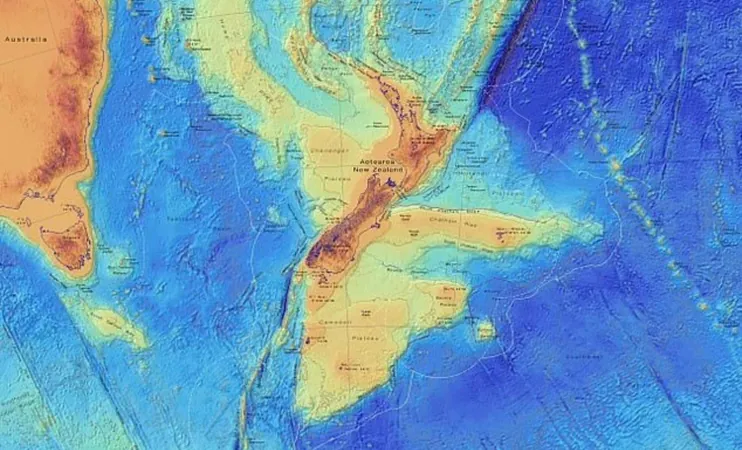
Zealandia Revealed: Earth's Eighth Continent Unearthed After 375 Years!
2025-01-20
Author: Jia
In a groundbreaking revelation, scientists have confirmed the existence of Zealandia, a colossal submerged continent that had remained hidden for nearly 400 years. Covering an astounding area of 1,890,000 square miles, this “lost” continent primarily lies beneath the ocean, shrouded under 2 kilometers of water. Known as Te Riu-a-Māui in the Māori language, Zealandia was first posited by Dutch explorer Abel Tasman in 1642, but it wasn’t until recent geological advancements that scientists could substantiate its existence.
A Geological Marvel: The History of Zealandia
The tale of Zealandia stretches back nearly 500 million years, tracing its roots to the supercontinent of Gondwana, which included modern-day Antarctica, Australia, South America, and Africa. The continent began breaking away about 100 million years ago as tectonic forces tore Gondwana apart. However, unlike many landmasses that emerged following such splits, Zealandia faced significant subsidence—approximately 94% of this landmass sank, leaving only parts of New Zealand and New Caledonia exposed.
What catalyzed this dramatic descent remains an enigma. Experts believe that the stretching and thinning of the continental crust contributed to Zealandia’s unique fate, rendering it almost invisible beneath sediment layers and ocean.
The Quest for Zealandia: A Journey of Discovery
Interest in Zealandia surged in 2017, when researchers from GNS Science utilized cutting-edge seafloor mapping and drilling methods to delineate the submerged landmass. Despite its potential, skepticism within the scientific community delayed Zealandia’s official classification as a continent due to its unusual features.
Studying Zealandia posed formidable challenges, primarily its depth—considered to be one of the most profound hurdles in contemporary geology. In the words of Robert Sutherland, a geophysics professor at Victoria University of Wellington, “Discoveries are immensely challenging when the subject lies 2 kilometers underwater, and there are essential sediment layers even further down.” This immense depth necessitated significant financial investments and advanced technologies for exploration.
Nonetheless, researchers successfully compiled geological evidence that supports Zealandia's continental classification, revealing a unique composition that corresponds with standard continental characteristics.
The Rediscovery of Zealandia: A Hidden Giant
This astonishing reshaping of our planet’s geographical knowledge illustrates how significant truths can lie undiscovered in plain sight. Zealandia, nearly two-thirds the size of Australia, was susceptible to being overlooked due to its submerged status. According to Andy Tulloch, a prominent scientist at GNS Science, “This exemplifies how the obvious can remain elusive for an extended period.” The distinct geological traits, such as its thicker crust compared to neighboring ocean floors, offered the first signs that Zealandia was more than mere oceanic crust.
With technological advancements, scientists are piecing the narrative of Zealandia together, confirming its status as Earth’s eighth continent. This discovery serves as a potent reminder that our understanding of Earth is ever-evolving, and much remains hidden below the surface.
Why Zealandia Matters: Implications for Science and Beyond
The recognition of Zealandia is a monumental moment for geology, offering fresh perspectives on the formation and evolution of landmasses. Researchers anticipate that delving into Zealandia will yield significant insights into how continents separate and sink, enhancing our understanding of the geological forces acting on Earth for millions of years. Its relationship with the ancient Gondwana supercontinent makes Zealandia a crucial piece in the puzzle of tectonic plate movements.
Additionally, the submerged nature of Zealandia may house undiscovered marine ecosystems and species, which have quietly adapted over time. The ongoing exploration may not only reveal biodiversity but also help scientists understand how marine life interacts with landmasses and responds to rising sea levels.
A New Era of Scientific Exploration
Zealandia's rediscovery signifies the dawn of a new chapter in scientific exploration, showcasing modern technology's potential to unlock nature's mysteries. Its confirmation as the eighth continent emphasizes the necessity for international cooperation and innovative exploration techniques. With over 70% of Earth’s surface hidden beneath oceans, Zealandia raises pressing questions about what other secrets might await discovery.
As exploration continues, Zealandia's significance as a historical archive of geological, climatic, and biological processes becomes increasingly apparent. This astonishing continent stands as a testament to humanity's relentless pursuit of knowledge, urging us to continue seeking out the planet’s hidden stories that lie beneath the waves.
Are you as excited about this discovery as we are? Share your thoughts below!



 Brasil (PT)
Brasil (PT)
 Canada (EN)
Canada (EN)
 Chile (ES)
Chile (ES)
 Česko (CS)
Česko (CS)
 대한민국 (KO)
대한민국 (KO)
 España (ES)
España (ES)
 France (FR)
France (FR)
 Hong Kong (EN)
Hong Kong (EN)
 Italia (IT)
Italia (IT)
 日本 (JA)
日本 (JA)
 Magyarország (HU)
Magyarország (HU)
 Norge (NO)
Norge (NO)
 Polska (PL)
Polska (PL)
 Schweiz (DE)
Schweiz (DE)
 Singapore (EN)
Singapore (EN)
 Sverige (SV)
Sverige (SV)
 Suomi (FI)
Suomi (FI)
 Türkiye (TR)
Türkiye (TR)
 الإمارات العربية المتحدة (AR)
الإمارات العربية المتحدة (AR)